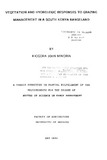Vegetation and hydrologic responses to grazing Management in a south Kenya rangeland
Abstract
Title: Vegetation and hydrologic responses to grazing
management in a South Kenya rangeland
~ J.K. Mworia
A study was conducted to evaluate the effects of three
selected stocking densities ./ on infiltration rate, bulk
density, sediment production and animal performance in a south
Kenya rangeland. The stocking densities used were 0, 4, 8, and
16 heifers/Ha, hereafter referred to as control (CL), light
density (LD), medium density (MD) and high density (HD)
respectively. Each treatment was replicated twice on plots
measuring 0.5 Ha each. The study was done at National Range
Research Center, Kiboko. The study site is classified as a
bushed grassland with species of Acacia and Cornrniphoras the
dominant woody plants, while Digitaria macroblephera and
Chloris roxburghiana are the most dominant grasses. The
texture of the soils at the site is sandy clay loam.
The highest stocking density, HD, gave the highest animal
output per hectare yielding a peak weight gain of 104 kg/Ha,
which however declined after pasture deterioration. The HD
treatment also produced the highest soil loss, lowest
infiltration rate, and highest bulk,density. The LD treatment
maintained the highest animal output per head and had the
least negative impact on the pasture hydrologic conditions and
vegetation. Infiltration rate after 30 minutes of simulated
vi
rainfall in HD plots was 4S% and 27% lower than in CL and LD
plots respectively, making a significant difference (p<O.OS).
Sediment production on the last sampling date was IllS kg/Ha
in HD treatment, which was significantly (p<o.S) more than 226
and S17 kg/Ha for the CL and LD respectively. Bulk density, 0-
Scm, in HD increased by lS% by the end of the experiment and
was significantly higher (p<O.OS) than CL and LD.
It can be concluded from this study that the effects of
high stocking densities on the range were, increased land
bareness, reduced infiltration rates, increased soil loss, and
increased soil compaction. The linear relationship of stocking
density to output per head developed in this study could vary
from year to year due to climatic and other environmental
variations; further studies are necessary to develop long-term
relationships.

